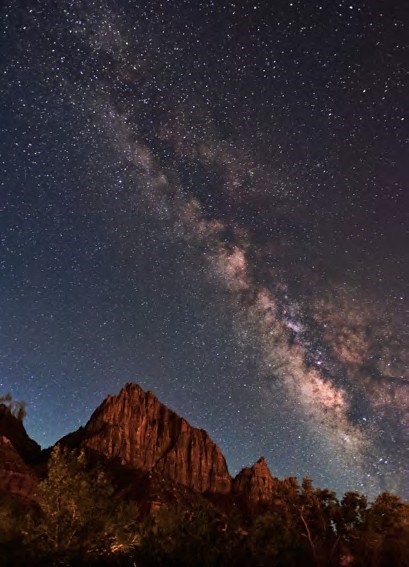
NPS Photo
What is a "Natural Lightscape?"
The National Park Service (NPS) uses the term "natural lightscape" to describe resources and values that exist in the absence of artificial light sources at night. Natural lightscapes make nighttime scenery, such as a starry sky, easier to view and are critical for maintaining nocturnal habitat for wildlife. Many species rely on natural patterns of light and dark to cue behaviors, such as navigating the landscape and hiding from predators. Lightscapes have cultural value as well, and they may be integral to the historical character of a location. Artificial light at night may be obtrusive in the same manner that man-made noise can disrupt a peaceful place. Light that is undesirable in a natural or cultural landscape is often called "light pollution."
Protecting natural lightscapes in national parks is important to the Service, and the Director identified it as Action 27: "Starry, Starry Night" in A Call to Action: Preparing for a Second Century of Stewardship and Engagement. To help achieve this goal and prevent the loss of natural night skies, the NPS seeks the cooperation of concessioners.
Light pollution is a relatively easy environmental problem to solve. Solutions are immediate and effective, and they often save money. It only takes a bit of knowledge and effort to choose night-sky-friendly outdoor lighting to protect the natural lightscape.
What Can Concessioners Do To Protect the Night Sky?
Use Light Only When You Need It
- Reduce or eliminate the use of landscape lighting and way-finding lighting as appropriate.
- Eliminate lights that do not enhance safety. Sometimes, fewer and lower intensity security lights can actually enhance safety by eliminating dark shadows caused by bright security lights.
- Use motion sensors to turn lights on and off as needed. This costs less money, improves security, and reduces light pollution. Also consider using timers for lights that are needed only in the evening or early morning.
- Consider lightscape impacts from illuminated signs and outside vending machines as well as other lighting.
Direct and Shield Your Lights
Make sure the light you are using is directed most efficiently. Try to orient lights downward to protect night sky. Check that adjustable lights are properly aimed on a regular basis. Shielded or full cutoff fixtures, such as this, direct all light downward.
Shielded fixtures allow no light to shine above the horizon. Several types of full cutoff light fixtures are now available for commercial use. Existing lights can be retrofitted with simple metal shrouds.
Reduce impacts from interior lighting, as well. Consider awnings, blinds, and shades that can be closed. Use these controls where appropriate, and even consider automatic shades.
Use Less Light
When properly directed, an efficient shielded light fixture can use a smaller wattage bulb and still be effective. In most cases, it is preferred to have two low-output lights with good glare control than one high-output If every outdoor light across America was made to be night-sky- friendly, it would save between $2 billion and $10 billion annually in electricity usage. light. Replace incandescent bulbs with CFLs. Replace mercury, metal halide, and first generation blue-light LED lights with sodium vapor lights.
Inform
Share your appreciation of the night and ways to protect it with visitors and staff. Encourage them to make the night a better place to experience a natural night sky.
Take a Nighttime Tour of Your Property for Yourself
A good way to find opportunities to improve the natural lightscape at your property is to get outside at night and look for yourself. As you walk around the property, identify places where the ideas described in this fact sheet might be employed. Run tests to see what practices work best, being careful not to impact visitor and employee safety. In some situations, you may have to balance interests in safety, way- finding, and even ambiance with natural lightscape protection. Talk to your park about such decisions when you have questions.
If every outdoor light across America was made to be night-sky- friendly, it would save between $2 billion and $10 billion annually in electricity usage.
Last updated: January 16, 2020
